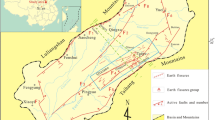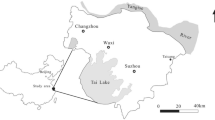Abstract
Earth fissures (EF) form in the northeastern Beijing Plain, causing horizontal and vertical displacements of the ground surface and damaging hundreds of buildings and roads. In addition, since 2009, an unprecedented number of cracks with vertical offsets have occurred in the Beijing Capital International Airport (BCIA), which is the busiest airport in China, causing serious financial losses and increasing the risk of air travel. The EF were divided into three groups, including EF1, EF2, and EF3, based on their distribution and deformation patterns. In general, the EF1 and EF2 fissures formed along segments of the NE-SW trending regional normal faults and have large vertical offsets but small widths. The deformation patterns, trenches and geophysical prospecting profiles, demonstrate that the EF1 and EF2 fissures propagated from the preexisting faults. In contrast, the EF3 fissures formed in a disorganized pattern above the paleochannels of the Chaobai River with short lengths and negligible vertical offsets. The monitoring data for the EF1 fissures indicates that the formation and deformation of the EF in the northeastern Beijing Plain were induced by groundwater pumping. The formation processes of the EF1, EF2, and EF3 fissures are classified into two categories: (1) on the existence of preexisting normal faults and (2) on the existence of paleochannels. Two hypothetical conceptual models are presented to illustrate the formation processes.





















Similar content being viewed by others
References
Al Fouzan F, Dafalla MA (2013) Study of cracks and fissures phenomenon in Central Saudi Arabia by applying geotechnical and geophysical techniques. Arab J Geosci 7(3):1157–1164
Ayalew L, Yamagishi H, Reik G (2004) Ground cracks in Ethiopian Rift Valley: facts and uncertainties. Eng Geol 75(3–4):309–324
Beijing Hydrogeological and Engineering Geological Survey (2007) Preliminary regional engineering geological exploration report in Shunyi new town, Beijing. Unpublished report (in Chinese)
Beijing Hydrogeological and Engineering Geological Survey (2014) Special exploration report on subsidence, earth fissures in Beijing-Shenyang passenger dedicated railway (Beijing section). Unpublished report (in Chinese)
Budhu M (2008) Mechanics of earth fissures using the Mohr-Coulomb failure criterion. Environ Eng Geosci XIV(4):281–295
Budhu M (2011) Earth fissure formation from the mechanics of groundwater pumping. Int J Geomech 11(1):1–11
Budhu M, Adiyaman I (2012) Earth fissure formation from groundwater pumping and the influence of a stiff upper cemented layer. Q J Eng Geol Hydrogeol 45(2):197–205
Chiaradonna A, Tropeano G, d’Onofrio A, Silvestri F (2019) Interpreting the deformation phenomena of a levee damaged during the 2012 Emilia earthquake. Soil Dyn Earthq Eng 124:389–398
Conway BD (2015) Land subsidence and earth fissures in south-central and southern Arizona, USA. Hydrogeol J 24(3):649–655
Cui X, Xie F, Li R, Zhang H (2010) Heterogeneous features of state of tectonic stress filed in North China and deep stress in coal mine. Chin J Rock Mech Eng 29(supp.1):2755–2761 (in Chinese)
De Filippis L, Faccenna C, Billi A, Anzalone E, Brilli M, Ozkul M, Soligo M, Tuccimei P, Villa IM (2012) Growth of fissure ridge travertines from geothermal springs of Denizli Basin, western Turkey. Geol Soc Am Bull 124(9–10):1629–1645
Foster S, Garduno H, Evans R, Olson D, Tian Y, Zhang W, Han Z (2004) Quaternary aquifer of the North China plain - assessing and achieving groundwater resource sustainability. Hydrogeol J 12(1):81–93
Gaur VP, Kar SK, Srivastava M (2015) Development of ground fissures: a case study from southern parts of Uttar Pradesh, India. J Geol Soc India 86(6):671–678
Ghazifard A, Moslehi A, Safaei H, Roostaei M (2016) Effects of groundwater withdrawal on land subsidence in Kashan plain, Iran. Bull Eng Geol Environ 75(3):1157–1168
Guo H, Zhao J (2018) The surface rupture zone and paleoseismic evidence on the seismogenic fault of the 1976 Ms 7.8 Tangshan earthquake, China. Geomorphology 327:297–306
Helm DC (1994) Hydraulic forces that play a role in generating fissures at depth. Bull Assoc Eng Geol 31(3):293–304
Hernandez-Marin M, Burbey TJ (2009) The role of faulting on surface deformation patterns from pumping-induced groundwater flow (Las Vegas Valley, USA). Hydrogeol J 17(8):1859–1875
Hernandez-Marin M, Burbey TJ (2010) Controls on initiation and propagation of pumping-induced earth fissures: insights from numerical simulations. Hydrogeol J 18(8):1773–1785
Hernandez-Marin M, Pacheco-Martínez J, Burbey TJ, Carreón-Freyre DC, Ochoa-González GH, Campos-Moreno GE, de Lira-Gómez P (2017) Evaluation of subsurface infiltration and displacement in a subsidence-reactivated normal fault in the Aguascalientes Valley, Mexico. Environ Earth Sci 76(24):812
Jachens RC, Holzer TL (1982) Differential compaction mechanism for earth fissures near Casa Grande, Arizona. Geol Soc Am Bull 93(10):998–1012
Jiao Q, Qiu Z, Fan G (2005) Analysis on recent tectonic activity and seismicity of Babaoshan-Huangzhuang-Gaoliying fault in Beijing region. J Geod Geodyn 25(4):50–54 (in Chinese)
Li SR, Santosh M (2014) Metallogeny and craton destruction: records from the North China Craton. Ore Geol Rev 56:376–414
Li Y, Gong H, Zhu L, Li X, Wang R, Guo G (2017) Characterizing land displacement in complex hydrogeological and geological settings: a case study in the Beijing plain, China. Nat Hazards 87(1):323–343
Loli M, Kourkoulis R, Gazetas G (2018) Physical and numerical modeling of hybrid foundations to mitigate seismic fault rupture effects. J Geotech Geoenviron 144(11):04018083
Lu Q, Peng J, Deng Y, Li L, Feng L (2014) Failure characteristics and influence width of Beiqijia-Gaoliying ground fissure in Beijing. Geotech Invest Survey 6:5–11 (in Chinese)
McDonald RI, Weber K, Padowski J, Flörke M, Schneider C, Green PA, Gleeson T, Eckman S, Lehner B, Balk D, Boucher T, Grill G, Montgomery M (2014) Water on an urban planet: urbanization and the reach of urban water infrastructure. Glob Environ Chang 27:96–105
Miller MM, Shirzaei M, Argus D (2017) Aquifer mechanical properties and decelerated compaction in Tucson, Arizona. J Geophys Res Solid Earth 122(10):8402–8416
Nábělek J, Chen WP, Ye H (1987) The Tangshan earthquake sequence and its implications for the evolution of the North China Basin. J Geophys Res 92(B12):12615
Nikbakhti O, Hashemi M, Banikheir M, Basmenj AK (2017) Geoenvironmental assessment of the formation and expansion of earth fissures as geological hazards along the route of the haram-to-haram highway, Iran. Bull Eng Geol Environ 77(4):1421–1438
Pacheco-Martínez J, Hernandez-Marín M, Burbey TJ, González-Cervantes N, Ortíz-Lozano JÁ, Zermeño-De-Leon ME, Solís-Pinto A (2013) Land subsidence and ground failure associated to groundwater exploitation in the Aguascalientes Valley, México. Eng Geol 164:172–186
Pampeyan EH, Holzer TL, Clark MM (1988) Modern ground failure in the Garlock fault zone, Fremont Valley, California. Geol Soc Am Bull 100(5):677–691
Peng J, Xu J, Ma R, Wang F (2016) Characteristics and mechanism of the Longyao ground fissure on North China plain, China. Eng Geol 214:136–146
Pirajno F, Santosh M (2014) Rifting, intraplate magmatism, mineral systems and mantle dynamics in central-East Eurasia: an overview. Ore Geol Rev 63:265–295
Qi J, Yang Q (2010) Cenozoic structural deformation and dynamic processes of the Bohai Bay basin province, China. Mar Pet Geol 27(4):757–771
Qin XH, Zhang P, Feng CJ, Sun WF, Tan CX, Chen QC, Peng YR (2014) In-situ stress measurements and slip stability of major faults in Beijing region, China. Chinese J Geophy 57(7):2165–2180 (in Chinese)
Qin H, Andrews CB, Tian F, Cao G, Luo Y, Liu J, Zheng C (2018) Groundwater-pumping optimization for land-subsidence control in Beijing plain, China. Hydrogeol J 26(4):1061–1081
Sheng ZP, Helm DC, Li J (2003) Mechanisms of earth fissuring caused by groundwater withdrawal. Environ Eng Geosci 9(4):351–362
Wang H, Yang Y, Liu M, Jia S, Tian F (2013) Analysis of the activity of the Gaoliying ground fissure (Beijing), based on automatic monitoring. Shanghai Land Resour 34(2):64–67 (in Chinese)
Xu J, Peng J, An H, Wang F, Sun H, Hu H, Yang B (2019) Paleochannel-controlled earth fissures in Daming, North China plain and their implication for underground paleogeomorphology. Geomorphology 327:523–532
Yakubchuk AS (2009) Revised Mesozoic–Cenozoic orogenic architecture and gold metallogeny in the northern Circum-Pacific. Ore Geol Rev 35(3–4):447–454
Yang Y, Li GM, Dong YH, Li M, Yang JQ, Zhou D, Yang ZS, Zheng FD (2011) Influence of south to north water transfer on groundwater dynamic change in Beijing plain. Environ Earth Sci 65(4):1323–1331
Yu Y, Song X, Zhang Y, Zheng F, Liang J, Han D, Ma Y, Bu H (2013) Identification of key factors governing chemistry in groundwater near the water course recharged by reclaimed water at Miyun County, northern China. J Environ Sci 25(9):1754–1763
Zhang Y, Ma Y, Yang N, Shi W, Dong S (2003) Cenozoic extensional stress evolution in North China. J Geodyn 36(5):591–613
Zhang S, Nie G, Liu X, Ren J, Liu G (2005) Quaternary activities of northern segment of the Shunyi-Liangxiang fault. Earthq Res China 21(1):84–92 (in Chinese)
Zhang Y, Wang Z, Xue Y, Wu J, Yu J (2015) Mechanisms for earth fissure formation due to groundwater extraction in the Su-Xi-Chang area, China. Bull Eng Geol Environ 75(2):745–760
Zhang J, Fan J, Xu H (2016a) Research on the sustainable development measures of the underground water source area in Beijing. Urban Geology 11(1):99–104 (in Chinese)
Zhang L, He J, Bai L, Cai X, Wang J, Yang T (2016b) The response relationship between the variation characteristics of deposition rate of quaternary depression basin on the northern margin of Beijing depression and the activity of Shunyi fault. Geol China 43(2):511–519 (in Chinese)
Zhang X, Zhang L, Cai X, Bai L (2016c) A study of structure and activity characteristics of the northern segment of Huangzhuang-Gaoliying fault in Beijing plain area. Geol China 43(4):1258–1265 (in Chinese)
Zhang L, Bai L, Zhao Y, Zhang X, Yang T, Cai X, He F (2017) The difference of deposition rate in the boreholes at the junction between Nankou-Sunhe fault and Huangzhuang-Gaoliying fault and its response to fault activity in the Beijing area. Seismology and Geology 39(5):1048–1065 (in Chinese)
Zhou Y, Guo G, Zhang L, Cai X, Lei K (2016) The division of quaternary strata and tectonic evolution in Houshayu Sag of Beijing. Geol China 43(3):1067–1075 (in Chinese)
Zhu L, Gong H, Li X, Wang R, Chen B, Dai Z, Teatini P (2015) Land subsidence due to groundwater withdrawal in the northern Beijing plain, China. Eng Geol 193:243–255
Acknowledgments
The authors are thankful to the Beijing Hydrogeological and Engineering Geological Survey for providing valuable data. The authors are also grateful to the editor-in-chief and the reviewers for the constructive comments which helped in improving our paper.
Funding
This research was funded by the China Geological Survey (Grant No. DD20160267, DD20190317).
Author information
Authors and Affiliations
Corresponding author
Rights and permissions
About this article
Cite this article
Wan, J., Li, B., Tan, C. et al. Characteristics and main causes of earth fissures in northeastern Beijing Plain, China. Bull Eng Geol Environ 79, 2919–2935 (2020). https://doi.org/10.1007/s10064-020-01731-z
Received:
Accepted:
Published:
Issue Date:
DOI: https://doi.org/10.1007/s10064-020-01731-z




